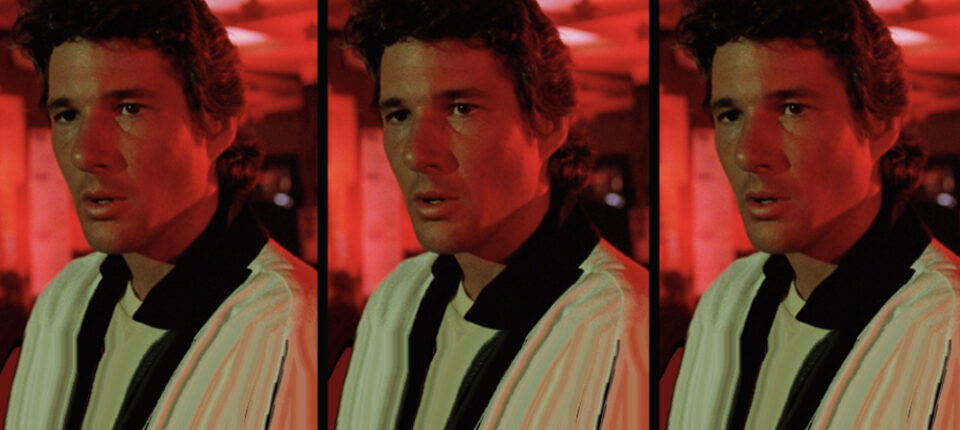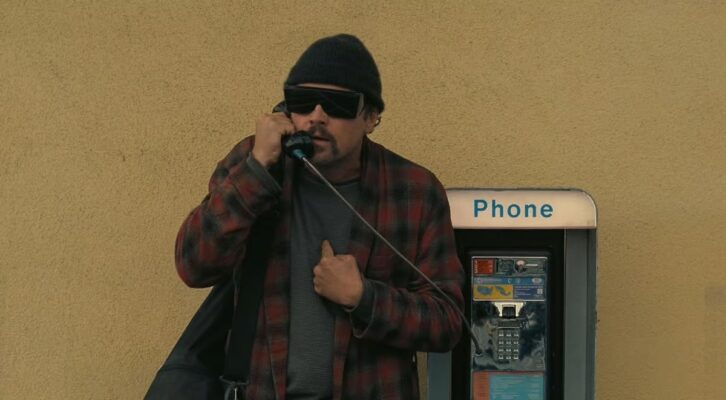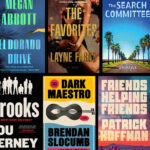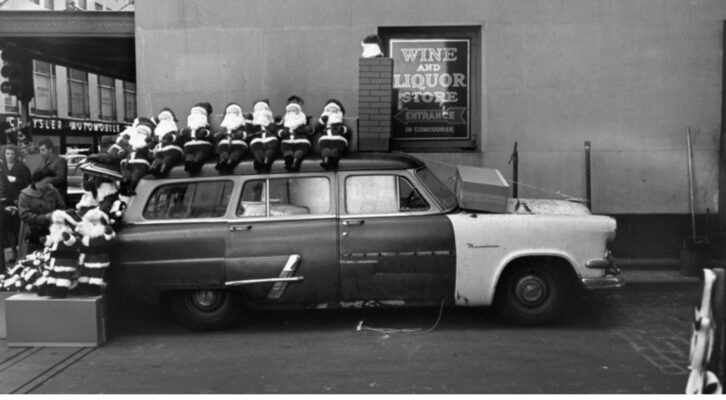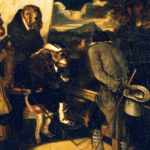Breathless (1983) is a textbook-perfect example of how to create a great remake. It offers many of the same narrative pleasures which helped make Jean-Luc Godard’s first film of the same name a highly influential cinematic phenomenon. But at the same time, writer-director James McBride and his collaborators behind and in front of the camera find numerous ways to make their version of this film feel vibrant and alive in ways that are completely original to it.
From a storytelling standpoint, these two versions of Breathless are nearly identical. Both films center on a young car thief (Jean-Paul Belmondo in the original, Richard Gere in the remake) who set off for a major city (Paris, Los Angeles) to win back an old girlfriend (Jean Seberg, Valérie Kaprisky). Both protagonists accidentally kill a cop before they get there. Upon arriving in their metropolis of choice, both protagonists find that their intelligent, yet dispassionate, ex-girlfriends don’t want to get involved with them again until they convince them to give their relationship another shot. The protagonists also deal with police manhunts for them, have pop cultural fixations which reveal a key part about their character, and even try to make a business deal at a junkyard. Even the endings hinge upon the same plot point, which is a betrayal committed by someone the protagonist loves.
You might think that the fidelity of McBride’s version of Breathless to the original would be a weakness. Instead, it preserves all the delights of its original story, which came from a treatment by Francois Truffaut (who was inspired by an article he had read) and Claude Chabrol (who was uncredited and also served as a “technical advisor”). It perfectly depicts the mixture of life as a low-level criminal (the protagonists never do anything grander than steal a car), exciting chase scenes, and playful romance which helped make the first version of Breathless so exciting and interesting on a narrative level.
Breathless (83) feels like a cover of a great song done in a different genre: the lyrics may be the same, but the style with which the artists are telling it makes it feel distinctive from the first version. Godard’s Breathless, with its 16mm black and white cinemaphotography by Raoul Coutard (a future legend who at that point in his career had only worked on four films) and handheld camerawork which makes you feel like you are in Paris experiencing the film’s events yourself, feels like a documentary.
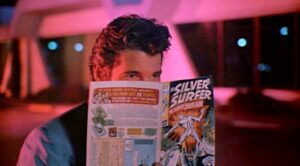
This was a comparison noted by Godard himself, who referred to it as “a documentary about Jean-Paul Belmondo and Jean Seberg,” as well as celebrated documentarian D.A. Pennebaker, who noted in an interview that Godard’s method in this film was “definitely [taken] from, the existing documentary films of the time” and were driven by the same creative impulses. Its sense of realism and immersiveness makes it feels like it could play as the second half of a double bill with Primary (1960), a highly influential documentary which Pennebaker said that Godard had seen and admired.
You could never mistake Breathless (83) for a documentary. It has a subtle, yet persistent love of artifice which gives it a distinctive visual identity from Godard’s version. This is apparent from the first shot, in which red neon light bathes protagonist Jesse Lujack (Gere) as he stands on a street corner in the Las Vegas Strip. While the light owes something to real locations, its effect is to make the world around Jesse feel a little more heightened and colorful. The color palette which McBride and his cinematographer, Richard H. Kline (who had received two Academy Award nominations after he had worked on dozens of films, none which were shot in black and white) emphasizes bright primary colors, most of which are red or blue. They make the world surrounding Jesse look like a children’s book, which goes well with the innocent quality Gere gives to him.
Even shots of real locations have a small touch of surrealness to them, like the one in which Jesse stands outside at night against a backdrop of lights from a faraway city in the San Fernando Valley, which makes him seem like he is standing in front of a wall of stars as shiny and distant as the future he conjures for Monica where they will be happy together in Mexico.
McBride goes on to make the world around his protagonist seem a little unreal in other ways. There’s his use of rear projection photography (a technique commonly used in American studio films from the 1950s involving pre-recorded footage being projected onto a screen behind actors) when Jesse drives around with Monica in Los Angeles, which makes their interactions feel even more real and vivid more because the background behind them feels so artificial. Or the way the camera spins around Jesse and Monica as they make out in a stolen car, their emotions dictating its movement like how dancers would dictate where a camera would be in an American musical. Everything about this film’s visual style makes you feel like you are not watching a documentary about the facts of a couple’s relationship, but a maximalist poem about what it feels like to be young and in love while living a life of crime.
In addition to creating a different technical style for his version of Breathless, McBride and his collaborators in front of the camera offer different takes on the original film’s most iconic characters. In the first version the protagonist was named Michel, and he seemed to embody the idea of French cool. With his jaunty hat and ever-present cigarette, Michel sauntered through the world as if nothing could faze him, despite his numerous complaints. If Michel is cool, then Jesse is hot. He has a zest for life which his grey gallic counterpart lacks. McBride establishes this in an early scene where Jesse drives to Los Angeles. In the original, Michel had calmly talked to himself (aside from breaking the fourth wall to tell certain audience members to “get stuffed”) and blandly sang “la la la” to jazz on his way to Paris before a cop pulled him off to the side of a road. But in the remake, Jesse excitedly delivers a monologue about how he is going to win back an architecture student named Monica (Kaprisky).
He then happily blares Jerry Lee Lewis’s song “Breathless,” singing along with the lyrics word-for-word and tapping his hands on the wheel to provide accompaniment to the music, which is already furiously frantic. This scene establishes that Jesse is a warmer and more childlike version of Michel. He’s more conventionally likeable, even if we might relate to Monica’s line that he is “like one of those rides at Disneyland – you make me dizzy.” If Michel felt like the cool older brother who wouldn’t want you anywhere near him because he was busy brooding over a love affair gone wrong, then Jesse is the younger brother who won’t leave you alone because he wants to distract you from seeing the wounds he is trying so desperately to hide.
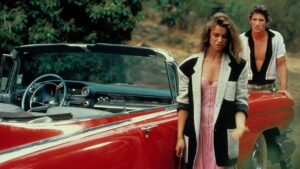
McBride also makes Jesse distinctive from Michel in terms of their different pop cultural fixations and how they relate to them. In Godard’s Breathless, his protagonist admires Humphrey Bogart. This is established when Michel sees a poster of him in Paris. He says “Bogie,” a nickname that implies familiarity even as Michel says it with reverence, perhaps the way a contemporary young woman would call Taylor Swift “Taylor.” Bogart, who had died three years before this film’s release, is clearly someone whom Michel admires, even though we never learn why. The sight of the picture even causes Michel to rub his thumb over his mouth, something which Bogart used to do in his films. It’s a brief yet memorable moment which establishes that Michel, despite his self-centeredness and arrogance, is vulnerable enough to feel the need to live up to the example of an older hero as well as being as much of a fan of American pop culture as his creators.
In contrast to Michel, whose idol is someone who was a real person, Jesse’s pop cultural hero is the fictional superhero known as The Silver Surfer. In his comic book series of the same name, The Silver Surfer is an alien who has been endowed with great power and a surfboard-like craft which he uses to live a nomadic lifestyle throughout the universe, saving people and longing to return to his lost love Shalla-Bal. The passionate emotions of these comics and the gloriously celestial style of their pop artwork make them a perfect pop cultural fixation for Jesse.
While Michel’s worship of Bogart is only depicted directly only once, and with some ambiguity as to why he would idolize him, Jesse’s admiration of The Silver Surfer is a recurring narrative motif throughout Breathless. It is one that begins as soon as the second shot of him, which features him holding and reading out loud from a Silver Surfer comic. There go on to be several shots in the rest of the film in which artwork from that issue (created by comics veterans John Buscema and Chris Stone), fills the screen, the score by Academy Award-winner Jack Nitzsche (for Best Original Song from An Officer and a Gentleman (1982), which also starred Richard Gere) rapturously accentuating its beauty.
In addition, Michel’s love for Bogart was something that he kept to himself, while Jesse has a conversation with Monica about the Silver Surfer. It is clear from his description of that character – that he’s “looking for love” and is “trapped” – that he relates to him. It’s a more direct and extensive act of paying tribute that feels perfectly at home in an American movie, as opposed to a colder French New Wave film like its source material. But that’s fitting when you consider McBride’s goal in making this movie.
It might be surprising, considering both the artistic pedigree of the original version and McBride’s background in directing more experimental movies like David Holzman’s Diary (1967) and Glen and Randa (1971), to hear that his original desire to remake it was driven at least in part by commercial consideration. McBride said in an interview that someone in LA told him to find a piece of intellectual property to adapt because he felt it would be the only way for him to make a film. He chose Breathless (which he had loved) in part because it was a “known quantity.” That is a reason that would be familiar to modern studio executives who try to get the most out of their vast library of films by remaking them or setting new movies in the worlds of their well-regarded classics, as well as to the directors who create them.
But McBride made Breathless (83) work so well, like any good remake, because he was willing to update it for a different context. He noted that he “decided to make it more like a Hollywood movie,” which he did in part by taking the story and ““set[ting] it in an entirely different world.” He ultimately approached the task of updating one of the most famous films in world cinema history not as a commercial artist trying to wring some extra money out of a beloved masterpiece, but as a translator who sought to make it feel new and alive in a brand-new way by making it something that Godard arguably loved more than anything else: an American crime movie.
Breathless (83) performed decently at the American box office (McBride also notes it was a big hit in France), but it also received mixed reviews in America. Its legacy has grown over the years, however. Film writer Travis Woods has noted that it “essentially created a new filmmaking vocabulary, prefiguring the pop-addled, video-stored filmographies of artists like Quentin Tarantino, Paul Thomas Anderson, and Michel Gondry.” One of those filmmakers he mentioned, Tarantino, is such a big fan of McBride’s Breathless that he has a poster of it permanently hanging in the New Beverly, a movie theater he owns in Los Angeles. But, even more than that, Breathless (83) deserves to be remembered as one of the great remakes.
It proves that, with a paradoxical mixture of fidelity and freshness, an artist can enable people to enjoy the pleasures of a well-worn classic while still finding new ways to make a familiar story feel exciting and original. Let us hope that future filmmakers as well as those working today study it as a guide for how to create their own fresh versions of older films that will be artistically original while preserving what made audience fall in love with them in the first place, and that more than a few of them will be so exciting they will leave us…breathless.

